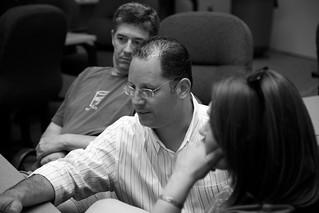 What are some concrete and powerful pedagogical approaches you can leverage in a 1-to-1 or BYOD teaching environment? What sort of practices shift the focus of teaching and learning from Lower Order Thinking Skills (LOTS) to Higher Order Thinking Skills (HOTS)?
What are some concrete and powerful pedagogical approaches you can leverage in a 1-to-1 or BYOD teaching environment? What sort of practices shift the focus of teaching and learning from Lower Order Thinking Skills (LOTS) to Higher Order Thinking Skills (HOTS)?That might be a million dollar question, with many answers. Nothing works all the time, but everything works sometimes; successful learning is largely context dependent. The real question we need to ask is: "What works best in my context'?"
The slide deck below illustrates five concrete teaching practices that may be helpful in answering these questions. They grew out of several workshops I've lead with teachers discussing emerging practices in BYOD classrooms for encouraging teaching HOTS. It may be difficult to hit on all five ideas in every class you teach, and there will always be a place in our classrooms for teaching LOTS too. Nonetheless, having these rules of thumb knocking around in the back of your head can help create learning experiences for your students focused on HOTS.
Personalize Tasks to Students' Life Experiences
This is sometimes described as "personalized learning". Both the Alberta Initiative for School Improvement (AISI) and the British Columbia Education Plan discuss and share resources for personalizing learning.
Publish
When students know their work is being seen by an audience beyond the classroom it encourages them the "up their game" a bit and do better work.
Be aware that there are two sides to this coin; one positive (Social Facilitation) and one negative (Social Inhibition).
Collaborate on Group Worthy Tasks
Find ways to have your students collaborate on group worthy tasks. A group worthy task has two seemingly contradictory components: It both requires interdependence amongst students and individual accountability.
Carefully constructed group learning activities can foster students' academic and social growth and help close the achievement gap. (pdf)
Feedback
Giving effective feedback is hard. Dylan Wiliam says: "Feedback should cause thinking."
When you orchestrate feedback for your students from sources outside your classroom you also weave in the effects of many of the other rules of thumb mentioned above.
Teach Something
Teaching something is one of the most powerful ways to learn that something. As teachers, we all know that "knowing a thing" and "teaching a thing" is not the same thing. Find ways for your students to teach what they've learned from you to others. If they do that online they are also making a contribution to the global knowledge commons.
Have you used any of these ideas in your own classroom? What was that like? Leave me a comment and let me know.
- 3/16/2014 04:39:00 pm
- 1 Comments


